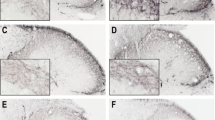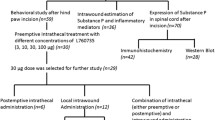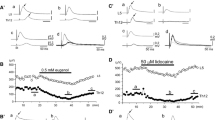Summary
Effects of dorsal root entry zone lesions (DREZLs) on cerebrospinal fluid (CSF) and plasma concentrations of neuropeptides, catecholamines, and cyclic nucleotides were studied in 9 patients with intractable chronic pain. Contents of β-endorphin-like-material in CSF decreased in all patients 12–17 days following DREZLs during which complete to good pain relief was achieved. Contents of β-endorphin-like-material in CSF increased again about one month after DREZLs in two and remained unchanged in one of three patients tested, who complained of partial reappearance of pain. Contents of β-endorphin-like-materials in plasma showed no significant changes after DREZLs. Substance P, noradrenaline, adrenaline, and cyclic nucleotide levels in both CSF and plasma were variable among the subjects and did not change significantly following the operations.
Thus, the results suggest that production of β-endorphin-like-material in the central nervous system is decreased by DREZL, though the increase in its turn-over might not be neglected. The mechanisms of the decrease in contents of β-endorphin-like-material in CSF after DREZLs were discussed in terms of our current knowledge of pain and pain inhibitory systems.
Similar content being viewed by others
References
Bouhassira D, Villanueva L, Le Bars D (1988) Intra-cereboventricular morphine decreases descending inhibitions acting on lumbar dorsal horn neuronal activities related to pain in the rat. J Pharmacol Exp Ther 247: 332–342
Carr DB, Bergland R, Hamilton A, Blume H, Kasting N, Arnold M, Martin JB, Rosenblatt M (1982) Endotoxin-stimualted opioid peptide secretion: two secretory pools and feedback control in vivo. Science 217: 845–848
Dehen H, Amsallem B, Colas Linhart N (1990) Cerebrospinal fluid beta-endorphin in chronic pain in man. Rev Neurol(Paris) 146: 155–157
Fields HL, Basbaum AI (1989) Endogenous pain control mechanisms. In: Wall PD, Melzack R (eds) Textbook of pain. Churchill Livingstone, Edingburgh, pp 206–217
Ho WK, Wen HL (1989) Opioid-like activity in the cerebrospinal fluid of pain patients treated by electroacupuncture. Neuropharmacology 28: 961–966
Höfkelt T, Ljungdahl A, Elde R, Nilsson G, Terenius L (1977) Immunohistochemical analysis of peptide pathways possibly related to pain and analgesia: enkephalin and substance P. Proc Natl Acad Sci USA 74: 3081–3085
Hosobuchi Y, Rossier J, Bloom FE, Guillemin R (1979) Stimulation of human periaqueductal gray for pain relief increases immunoreactive beta-endorphin in ventricular fluid. Science 203: 279–281
Ishijima B, Shimoji K, Shimizu H, Takahashi H, Suzuki I (1988) Lesions of spinal and trigeminal dorsal root entry zone for deafferentation pain. Applied Neurophysiol 50: 175–187
Kiser RS, Khatami M, Gatchel RJ, Huang X-Y, Bhatia K, Altshuler KZ (1983) Acupuncture relief of chronic pain syndrome correlates with increased plasma met-enkephalin concentrations. Lancet II: 1394–1396
Kumagai Y, Shimoji K, Honma T, Ishijima B, Hokari T, Fujioka H, Fukuda S, Ohama E, Uchiyama S (1992) Problems related to dorsal root entry zone lesions. Acta Neurochir (Wien): in press
Levine JD, Taiwo YO, Collins SD, Tarn JK (1986) Noradrenaline hyperalgesia is mediated through interaction with sympathetic postganglionic neurone terminals rather than activation of primary afferent nociceptors. Nature 323: 158–160
Levitzki A (1988) From epinephrine to cyclic AMP. Science 241: 800–806
Lipman JJ, Miller BE, Mays KS, Miller MN, North WC, Byrne WL (1990) Peak B endorphin concentration in cerebrospinal fluid: reduced in chronic pain patients and increased during the placebo response. Psychopharmacology (Berl) 102: 112–116
Magistretti PJ, Schorderet M (1984) VIP and noradrenaline act synergistically to increase cyclic AMP in cerebral cortex. Nature 308: 280–282
Marson L, Kiritsy-Roy JA, Van Loon GR (1989) μ-opioid peptide modulation of cardiovascular and sympathoadrenal responses to stress. Am J Physiol 257: R901-R908
Nashold BS Jr, Ostdahl RH (1979) Dorsal root entry zone lesions for pain relief. J Neurosurg 51: 59–69
Nashold BS Jr, Urban B, Zorub DS (1976) Phantom relief by focal destruction of substantia gelatinosa of Rolando. In: Bonica JJ, Albe-Fessard D (eds) Advances in pain research and therapy, Vol 1. Raven Press, New York, pp 959–963
Nathanson JA, Greengard P (1977) “Second messengers” in the brain. Sci Am 237: 109–119
O'Callaghan JP, Chess Q, McKimmey C, Clouet DH (1979) The effects of opiates on the levels of cyclic 3′,5′-guanosine-monophosphate in discrete areas of the rat central nervous system. J Pharmacol Exp Ther 210: 361–367
Owens PC, Smith R, Green D, Falconer L (1984) Effect of hypoglycemic stress on plasma and cerebrospinal fluid immunoreactive β-endorphin in conscious sheep. Neurosci Lett 49: 1–6
Puig MM, Laorden ML, Miralles FS, Olaso MJ (1982) Endorphin levels in cerebrospinal fluid of patients with postoperative and chronic pain. Anesthesiology 57: 1–4
Radosevich PM, Lacy DB, Brown LL, Williams PE, Abumrad NN (1988) Effects of insulin-induced hypoglycemia on plasma and cerebrospinal fluid levels of ir-β-endorphins, ACTH, cortisol, norepinephrine, insulin and glucose in the conscious dog. Brain Res 458: 325–338
Roerig SC, Fujimoto JM, Tseng LF (1988) Comparisons of descending pain inhibitory pathways activated by β-endorphin and morphine as characterized by supraspinal and spinal antinociceptive interactions in mice. J Pharmacol Exp Ther 247: 1107–1113
Sagen J, Parras GD, Pollard HB (1986) Analgesia induced by isolated bovine chromaffin cells implanted in rat spinal cord. Proc Natl Acad Sci USA 83: 7522–7526
Salar G, Alessio L, Govoni S, Battaini F, Iob I, Goss I, Trabucchi M (1991) Evaluation of beta-endorphin/beta-lipotropin immunoreactivity content in the CSF of patients affected by deafferentation pain syndromes. Pharmacol Res 23: 181–186
Shimoji K, Matsuki M, Naito E, Yoshida N, Satomi N, Endo H, Maruyama Y (1983) Pain alleviating mechanisms of epidural dorsal column stimulation in man. Changes in concentrations of β-endorphin, substance P catecholamines and cyclic nucleotides in cerebrospinal fluid. Masui (in Japanese) 32: 914–923
Sindou M (1972) Etude de la jonction radiculomédullaire postérieure. La radicellotomie postérieure sélective dans la chirurgie de la douleur. Médical Thesis, Lyon
Sjölund B, Terenius L, Eriksson M (1977) Increased cerebrospinal fluid levels of endorphins after electroacupuncture. Acta Physiol Scand 100: 382–384
Sjöström S, Tamsen A, Hartvig P, Folkesson R, Terenius L (1988) Cerebrospinal fluid concentrations of substance P and (met) enkephalin-ARG6-PHE7 during surgery and patient-controlled analgesia. Anesth Analg 67: 976–981
Stone TW, Taylor DA, Bloom FE (1975) Cyclic AMP and cyclic GMP may mediate opposite neuronal responses in the rat cerebral cortex. Science 187: 845–847
Terenius L (1978) Endogenous peptides and analgesia. Annu Rev Pharmacol Toxicol 18: 189–204
Terenius L (1987) Endorphins and substance P in chronic pain. In: Tiengo M, Eccles J, Cuello AC, Ottoson D (eds) Advances in pain research and therapy, Vol 10. Raven Press, New York, pp 9–15
Tiseo PJ, Adler MW, Liu-Chen L-Y (1990) Differential release of substance P and somatostatin in the rat spinal cord in response to noxious cold and heat; effect of dynorphin A(l-17). J Pharmacol Exp Ther 252: 539–545
Vocci FJ, Petty SK, Dewey WL (1978) Antinociceptive action of the butyryl derivatives of cyclic guanosine 3′,5′-monophosphate. J Pharmacol Exp Ther 207: 892–898
Watson E (1981) Liquid chromatography with electrochemical detection for plasma norepinephrine and epinephrine. Life Sci 28: 493–497
Yaksh TL (1978) Direct evidence that spinal serotonin and noradrenaline terminals mediate the spinal antinociceptive effects of morphine in the periaqueductal gray. Brain Res 160: 180–185
Yaksh TL (1988) Neurologic mechanisms of pain. In: Cousins MJ, Bridenbaugh PO (eds) Neural blockade in clinical anesthesia and management of pain, 2nd ed. JB Lippincott, Philadelphia, pp 791–844
Author information
Authors and Affiliations
Rights and permissions
About this article
Cite this article
Fujiwara, N., Shimoji, K., Kumagai, Y. et al. Effects of dorsal root entry zone lesions on CSF and plasma neuropeptides and catecholamines. Acta neurochir 117, 38–43 (1992). https://doi.org/10.1007/BF01400633
Issue Date:
DOI: https://doi.org/10.1007/BF01400633




